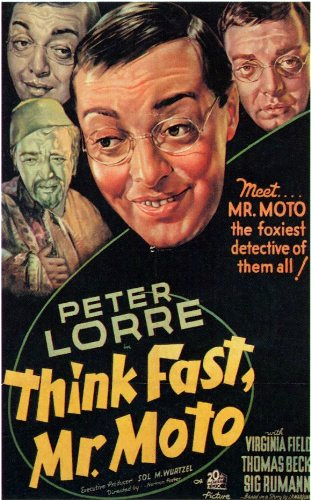Mr Moto (1938-1939)
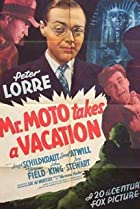
In setting up PLEX at home to use with the DVD collection, I started with the eight Mr Moto films to renew acquaintance with an old friend who can keep me company as I do the NYT crossword puzzles in the evenings, after Eggheads and Antiques Road Show (UK). Moto was sired by J. P. Marquand of Massachusetts. More on PLEX below.
Marquand went on to chronicle Boston’s Beacon Hill snobs in such satirical novels as The Late George Apley (1938), a best seller in its day and a Pulitzer Prize winner. Those that followed include Wickford Point (1939), H.M. Pulham, Esquire (1941), and Point of No Return (1949). While searching for themes and voices in haute literature which was his abiding ambition, Marquand wrote spy novels to make a living. The first was Mr Moto Takes a Hand (1935) with five more to come. The ever so prim entry in Wikipedia brackets the Moto novels apart from Marquand’s ‘Literary novels’ in the way the semi-literate do. The Moto novels are completely omitted in the section on Marquand’s life and work but relegated to a seperate ghetto, lest the children be upset.

Taken as a whole there are two interesting things about the Moto novels. The first is that they were written by society author with no interest or knowledge of the worlds therein portrayed. Second, the central character is a secret agent who is cold, calculating, and deadly — licensed to kill long before the NRA came along and granted every drooler that right — in the service of the expanding Japanese Empire. Marquand no doubt wanted his spy to be different in a crowded market of fictional spies, and he succeeded.
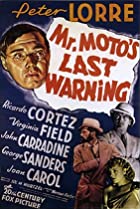
The popularity of Charlie Chan movies inspired the transfer of Moto from page to film in 1937, and a transformation from a reptilian assassin into a genial cicerone for naive American innocents abroad in the big wide world. Into those new shoes stepped Peter Lorre, who was desperate for work. He became the Good Jap(anese) in these films directed by Norman Foster whose pace seldom slackened, though for no sane reason Foster was replaced on the last two films. Hungarian László Löwenstein became a yellow face, as it was called at the time, Japanese. And, though Lorre was a sickly weakling, by this transformation he became a cat burglar, judo expert, marksman, and endurance athlete. His perennial bad health and heavy smoking were no matter on film.
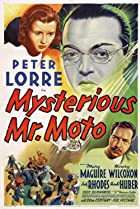
There is a third oddity with Moto that fades as the series continued. He murders villains. He does not arrest or sequester them, he just kills them. No European, still less a white-hatted Western, hero of the day would do that, taking the law into his own hands. The censor would not permit it, but they did permit it for an oriental. So in some of the early films he does what he did frequently in the book, saves time by murdering the villains. Only later does he go soft and start arresting them.
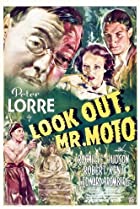
To balance that dark side, he is transmogrified into an American-educated, genial friend and protector of Americans abroad, while working for the International Police. He also got a first name: Kentaro. In the books, one of which I have read, he had only in initials, to wit, I. M. Moto. Say it out loud to get the point. It worked. The films were popular, but Japan was not and they came to an end. There is an uninformative entry on Moto in Wikipedia.
The films and their settings are these:
Think Fast, Mr Moto (1937) – Shanghai
Thank you, Mr Moto (1937) – Gobi Desert and Peking
Mr Moto’s Gamble (1938) – San Francisco
Mr Moto Takes a Chance (1938) – Siam jungle
Mr Moto’s Last Warning (1939) – Port Said, Egypt
Mr Moto in Danger Island (1939) – Puerto Rico
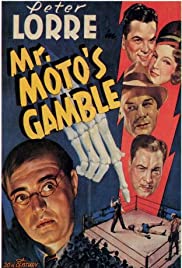
Mr Moto Takes a Vacation (1939) – San Francisco in archeological museum
Moto, Chan, Holmes were all broadcast after school and before dinner or practice. That is when and where I first became acquainted with them. Then some years later a series of Great Detectives aired on the CBC after the late news, and I watched most of them again.
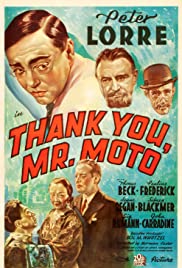
The PLEX media player promises a custom-made private service akin to Netflix, Hulu, or Amazon Prime. After loading the movies on a computer acting as a server, it translates and transmits them via the home wi-fi network to the television. In our case the computer is upstairs with the telly downstairs. Selecting a film is done with the Apple TV remoter. Sounds easy.

Kate, Queen of the Buttons to Push, had the devil of time setting it up, stopping and restarting at least once when nearly defeated by the comPLEXity of PLEX. Once that mission was accomplished, my part has been to load the database with movies and I, too, have found that perPLEXing. There is a mountain of information on the web, including You Tube, which I find of no use. It is like looking for a unicorn in a constellation to find answers to my simple questions among the geekerati. Most of the sites are in Geekese, while those that are not as technical are dedicated to showing how to change the background colours, but none about how to get it work in the first place.
Leaving those grumbles aside, when it works, it is a welcome luxury. No longer is there a hunt to find a DVD (shelved upstairs where there is some order, in the garage where there is none, or is it in the office), cleaning it, inserting it in the DVD player which can be shy at times, cleaning it again and reinserting it, (finding it is damaged [by canine teeth marks!] and will not play), finding the dedicated DVD remoter (with its usual dead batteries), and then watching the DVD skip over damaged sections though it has never been played before.
For further reading see ‘Plex (software)’ on Wikipedia.

